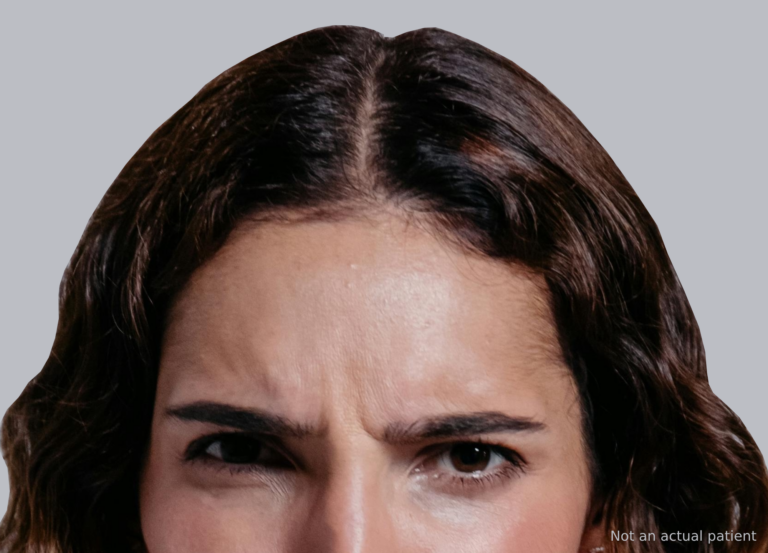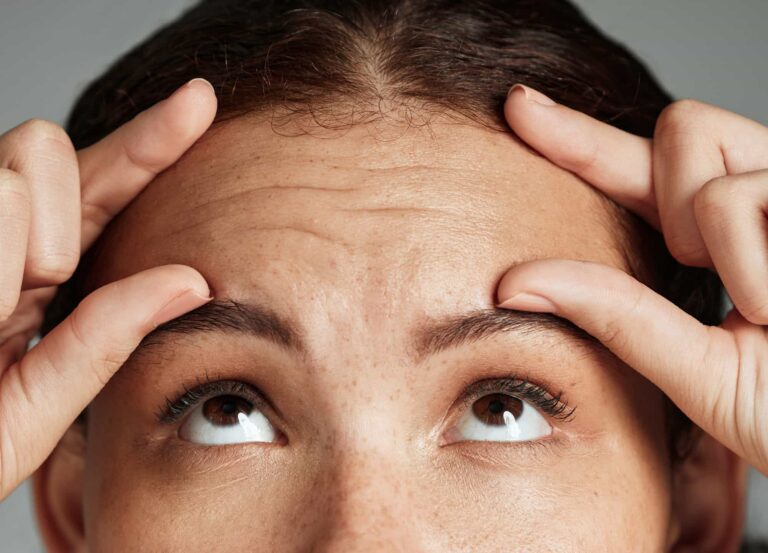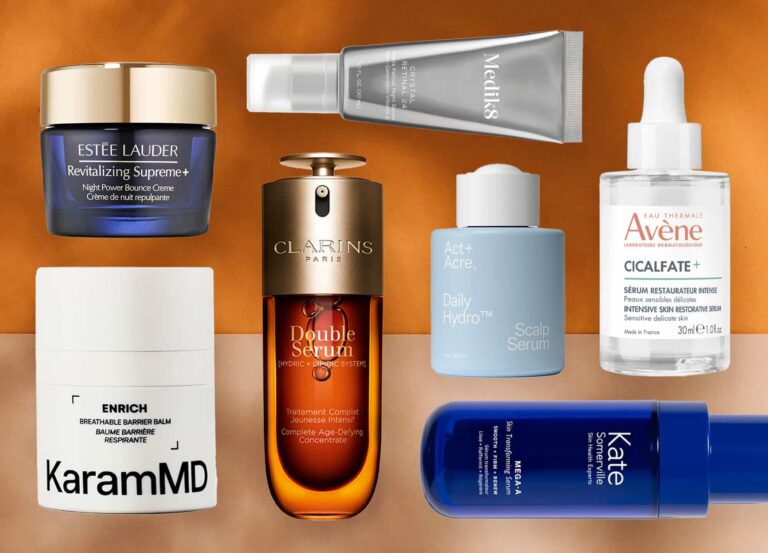Sunspots, melasma, post-pimple stains—when excess pigment surfaces, stippling or splotching the otherwise consistent canvas of our skin, we tend to register only its unwelcomed irregularity.
But regardless of what spurs it—the sun, heat, hormones, the unstoppable swell of a mosquito bite—the pigment, or melanin, composing dark patches and spots actually serves an important purpose. The melanocytes at the bottom of our epidermis unleash pigment in a move to protect skin cells from injury. Not only does melanin absorb some degree of ultraviolet radiation, shielding our DNA from cancer-causing damage, but it acts as an antioxidant as well, quenching the destructive free radicals implicated in virtually every sign of aging.
Of course, those good intentions aren’t usually what we see when we look in the mirror.
Mottling can rob skin’s radiance and add years—and be an exhausting adversary, to boot. Once in bloom, it’s fiercely stubborn and often recurrent. And even our most conscientious efforts to treat discoloration can easily backfire, intensifying hyperpigmentation and leaving us defeated.
Whether addressing post-inflammatory hyperpigmentation (PIH) in black and brown skin or sun-fueled spots on lighter complexions, “treating discoloration is a delicate balance of obtaining effective results without irritating the skin, as many brightening ingredients can be mildly irritating,” says Dr. Elyse Love, a board-certified dermatologist in New York City. And irking the skin in any way, even while aiming to improve it, can unintentionally ramp up pigment synthesis.
Since knowing which products to trust and how to use them is an integral part of evening out the complexion, we asked dermatologists to share the most proven players in the brightening realm.
Sunscreen
If your hyperpigmentation plan doesn’t include sunscreen, you can stop reading right here. “I always tell patients that if they are treating hyperpigmentation without sunscreen, they are working against their progress and wasting their time,” says Dr. Corey L. Hartman, a board-certified dermatologist in Birmingham, Alabama. Whether or not UV rays are a primary instigator of your particular type of discoloration, they will absolutely worsen whatever marks you’re trying to get rid of. This goes for folks of all skin tones. While “darker-skinned individuals have larger melanocytes that contain more melanin,” he adds—and this affords them some degree of built-in sun protection—dermatologists universally recommend that everyone wear a broad-spectrum sunscreen with an SPF of 30 or higher.
Is sunscreen safe for all skin tones?
Absolutely. The best formulas for those with hyperpigmentation boast high percentages of the mineral filters zinc oxide and titanium dioxide, which deflect UV rays rather than absorbing them, as chemical sunscreens do. “The belief is that chemical filters release the energy they absorb as heat, which we know can exacerbate melasma,” says Dr. Dhaval Bhanusali, a board-certified dermatologist in New York City. Chemical sunscreens can also be irritating, sparking post-inflammatory hyperpigmentation, or dark marks that turn up in the wake of insult and inflammation.
Over the past few years, research has shown that visible light—emitted by the sun and screens—“can also play a role in hyperpigmentation disorders, particularly in darker skin types,” he adds. Iron oxides, the pigment particles in tinted sunscreens, are critical for those struggling with pigmentary conditions. “Your sunscreen won’t block visible light unless it contains iron oxides,” says board-certified Boston dermatologist Dr. Mitalee Christman.
Derm favorites
Alastin HydraTint Pro Mineral Broad Spectrum Sunscreen SPF 36, $55; EltaMD UV Clear Tinted Broad-Spectrum SPF 46, $38; La Roche Posay Anthelios Tinted Mineral Sunscreen Fluid SPF 50, $33.50; Isdin Eryfotona Ageless Ultralight Tinted Mineral Sunscreen, $66
Hydroquinone
Lauded as the “gold standard” among skin-lightening ingredients, hydroquinone (HQ) works by blocking tyrosinase—the enzyme that kicks off melanin production in the skin—and is a mainstay of treatment for PIH, melasma, and other pigmentary conditions.
HQ is available over the counter, in concentrations up to 2%, and by prescription, at strengths of 4% and up. Many dermatologists, Drs. Christman and Bhanusali included, commonly call on compounding pharmacies to mix up HQ formulations of 8% or 12%.
The ingredient “can be super-irritating by itself, but it’s also difficult to compound [or mix with other actives],” notes Dr. Bhanusali, who is the founder of Skin Medicinals, an online platform that connects doctors with compounding pharmacies, allowing them to build custom creams at affordable prices. A popular Skin Medicinals HQ formulation blends the lightener with botanical brightener kojic acid and antioxidant vitamin C to “help keep the HQ stable longer,” he says.
Is hydroquinone safe for all skin tones?
The most common side effect associated with HQ is irritant contact dermatitis—which, in those prone to PIH, can cause skin to overproduce pigment at the site of the perceived injury. “The ingredient is highly effective, but there is a potential risk of worsening hyperpigmentation if used incorrectly,” says Dr. Love, stressing that hydroquinone should be used only under the supervision of a board-certified dermatologist.
In patients with dark skin, HQ can present an additional dilemma. While most brightening agents work to normalize pigment production and should be applied to the full face, explains Dr. Love, “hydroquinone-based products [perform best] as spot treatments to avoid lightening the normal skin tone.”
When prescribing HQ to patients of color, Dr. Hartman also worries about unintentional skin bleaching, “which can often occur as a person aims to merely lighten dark spots initially.” He adds, “I take my role as a dermatologist seriously when it comes to preventing patients from going too far.”
Spot treating isn’t an entirely foolproof maneuver, however. If applied heavy-handedly, imprecisely, or in the wrong concentration, hydroquinone can cause “halo hypopigmentation,” warns Dr. Hartman, or a depigmented ring around the spot being treated, which “leads to accentuation of the hyperpigmentation.” To prevent the phenomenon, he suggests dabbing the cream directly on the affected area with a cotton-tipped applicator or toothpick “and using only enough product to be absorbed into the skin without residual cream being visible.”
Dr. Christman points out that “there is a risk of ochronosis with high concentrations [of HQ] used over a long time,” referring to a paradoxical and often permanent darkening of the skin, which was first reported in Africa but is, by all accounts, very uncommon in North America. Still, short courses and careful monitoring are key with hydroquinone.
Derm favorites
Skin Medicinals Lightening Cream, $45; Hydro-Q (Rx only); Tri-Luma Cream (Rx only)
Retinoids
With decades of studies supporting their powers, vitamin A–based creams—both Rx-strength tretinoin and less potent over-the-counter retinols and other derivatives—decrease tyrosinase output and increase cellular turnover to help dead surface cells slough off at a healthier clip. “With the peeling comes the pigment,” notes Dr. Bhanusali.
Are retinoids safe for all skin tones?
Yes—but those who are prone to PIH should definitely proceed with caution. Retinoids are “true workhorse products [with] so many benefits, including fading dark spots, affecting pore size, improving fine lines and wrinkles, and controlling acne—which is, by far, the most common skin condition leading to post-inflammatory hyperpigmentation in black and brown skin,” says Dr. Hartman. Oftentimes, he says, his patients seek treatment for PIH without realizing that acne-induced inflammation is to blame for bothersome marks. “That inflammation causes a breakdown of keratinocytes [epidermal cells] and melanocytes [melanin-making cells], which allows pigment to drop out between cells and into the dermis instead of remaining within the cells, where it’s supposed to be,” Dr. Hartman explains.
Of course, retinoids themselves, on their mission to eject stained cells, can also stir up inflammation—and, consequently, more melanin. It’s important to ease in, using a pea-size drop of retinoid only twice a week to start, and buffering skin with an anti-inflammatory moisturizer, like CeraVe PM Facial Moisturizing Lotion. At the first sign of irritation, back off and let skin recover for about a week before trying again, with a weaker formula, if need be.
Derm favorites
Differin Adapalene Gel 0.1% Acne Treatment, $15.49; La Roche-Posay Redermic R Retinol Cream, $49.99; SkinBetter AlphaRet Overnight Cream, $125
Vitamin C
Vitamin C, or l-ascorbic acid, “reduces tyrosinase, which prevents the overproduction of melanin in our skin,” explains Rhonda Davis, a cosmetic chemist in Mobile, Alabama. As an antioxidant, it also possesses modest sun-protective properties, bolstering the effects of sunscreen.
Is vitamin C safe for all skin tones?
It is. However, like its fellow brighteners, pure water-soluble vitamin C, in concentrations high enough to be effective, can sometimes aggravate the skin beyond the standard tingling sensation it normally imparts. More stable oil-based versions of vitamin C, like ascorbyl tetraisopalmitate, “can be used in high percentages without irritating the skin, making them ideal for those with sensitive or dry skin,” Davis adds. Dr. Bhanusali notes that while these ester forms are certainly less caustic, their efficacy—and how they compare to traditional l-ascorbic acid—is still a subject of debate in the dermatology community.
Derm favorites
Obagi Clinical Vitamin C + Arbutin Brightening Serum, $90; SkinCeuticals CE Ferulic, $166; BeautyStat Universal C Skin Refiner, $80; The Ordinary Ascorbyl Tetraisopalmitate Solution 20% in Vitamin F, $17.80; L’Oréal Revitalift Derm Intensives Vitamin C Serum, $30
Tranexamic acid
Commonly used to treat heavy menstrual bleeding, oral tranexamic acid (TXA) works by “slowing down the production of plasmin, an enzyme in blood that breaks up clotting material,” explains Dr. Christman. How exactly that translates to brighter skin is somewhat unclear, but experts theorize that by curbing plasmin, the drug prevents melanocytes from interacting with surrounding keratinocytes while also diminishing blood vessels and quelling inflammation.
“Since this medication [brand name: Lysteda] is used to stop bleeding, we worry about causing blood clots, but this is only a concern if you have a familial predisposition,” says Dr. Christman.
Is TXA safe for all skin tones?
While tranexamic acid is relatively new to the skin-care space, both oral and topical formulations have shown promise in treating challenging cases of melasma across skin types (though there’s currently more research on the oral form). “TXA pills can melt away resistant melasma like no other,” says Dr. Hartman, “but should be used for only short periods [under a dermatologist’s supervision], since they are associated with an increased risk of blood clots.” He’s seen impressive results from TXA creams as well and says “they’re best used as maintenance for an even complexion.”
“TXA is not associated with any irritation, as far as I have heard or seen,” adds Dr. Hartman. A number of studies have found it to be safe and effective for Asian patients with melasma. The ingredient “was being studied for hives in the 1970s in Asia, and they serendipitously noticed that patients’ melasma improved,” says Dr. Christman. “It’s been widely studied for melasma in Asia ever since and has been increasingly used for melasma in the U.S. in the past couple years.”
According to Dr. Bhanusali, trials are currently investigating TXA’s efficacy for other pigment disorders as well, including post-inflammatory hyperpigmentation from acne.
Derm favorites
Skinceuticals Discoloration Defense, $98; SkinMedica Lytera 2.0 Pigment Correcting Serum, $154; The Inkey List Tranexamic Acid Hyperpigmentation Treatment, $14.99
Cysteamine
Another rookie in the skin-brightening realm, the antioxidant cysteamine “inhibits the overproduction of tyrosinase, lightening dark spots for visibly brighter skin,” says Davis. It can be used to treat a variety of maladies, from melasma to sunspots to PIH.
“I love cysteamine for its ability to provide a truly even complexion in a short period of time,” says Dr. Hartman. Applied to the full face for 15 minutes as a (somewhat smelly) rinse-off mask, “it lightens as effectively as hydroquinone, without the risk of lightening too much or leading to the dreaded ochronosis,” he adds.
While some dermatologists use cysteamine as an alternative to HQ, others find it a valuable adjunct. Dr. Christman enlists it after weaning patients off a course of hydroquinone, having them apply it nightly for 16 weeks, then twice a week thereafter.
Is cysteamine safe for all skin tones?
Cysteamine is surprisingly mild-mannered, given its efficacy. Dr. Hartman has found it to be remarkably gentle on all skin types, “lightening even the notoriously difficult-to-treat eye area without irritating the delicate eyelid skin,” he says.
Its use as a short-contact therapy obviates much risk of irritation. “I’ve used it for almost two years now and have had only two patients complain about irritation,” Dr. Hartman says. “Both happened to be skin type V [brown skin], but I think that was more coincidental than anything. Both also had a history of contact dermatitis and were able to restart treatment once their underlying skin condition was controlled, with no problem.”
Derm favorite
Cyspera, $169
Exfoliating acids and botanical brighteners
Chemical exfoliants, like alpha hydroxy acids (AHAs) and beta hydroxy acids (BHAs), may not make a dramatic difference on their own, but our experts appreciate their ability to supercharge hyperpigmentation protocols both by managing acne (particularly in the case of the BHA salicylic acid) and allowing subsequent treatment ingredients to penetrate better. Popular plant-based brighteners—azelaic and kojic acids, arbutin and licorice extracts—work best in concert.
Are acids and botanicals safe for all skin tones?
Yes, in moderation. AHAs and BHAs are particularly foolproof if applied as rinse-off products. “I like to incorporate AHAs and BHAs in cleansers, since they can be associated with irritation and sun sensitivity in leave-on products,” notes Dr. Hartman. Dr. Christman finds mild home peels offer “lots of bang for your time and money.”
With antibacterial, anti-inflammatory, and tyrosinase-blocking powers, grain-derived azelaic acid is ideal for treating PIH. “It’s well-tolerated on all skin types, and Finacea [a prescription-strength topical] has long been considered a great option for patients with skin of color,” says Dr. Bhanusali. He’s also a fan of mushroom-culled kojic acid, which works like many of its counterparts, tamping down tyrosinase to calm pigment cells. “While not as strong as HQ, it can work on most forms of pigment,” he says. Hardly a solo act, it’s commonly found alongside a host of other acids and brighteners, like arbutin and licorice root extract.
Derm favorites
Neutrogena Pore Refining Exfoliating Cleanser, $8.50; Dermalogica Skin Resurfacing Cleanser, $45; The Ordinary AHA 30% + BHA 2% Peeling Solution, $7.20; Drunk Elephant Sukari Babyfacial, $80; AlumierMD Intellibright Complex, $86; La Roche Posay Mela-D Pigment Control, $40; Glytone Dark Spot Corrector, $40; PCA Skin Pigment Gel, $64











